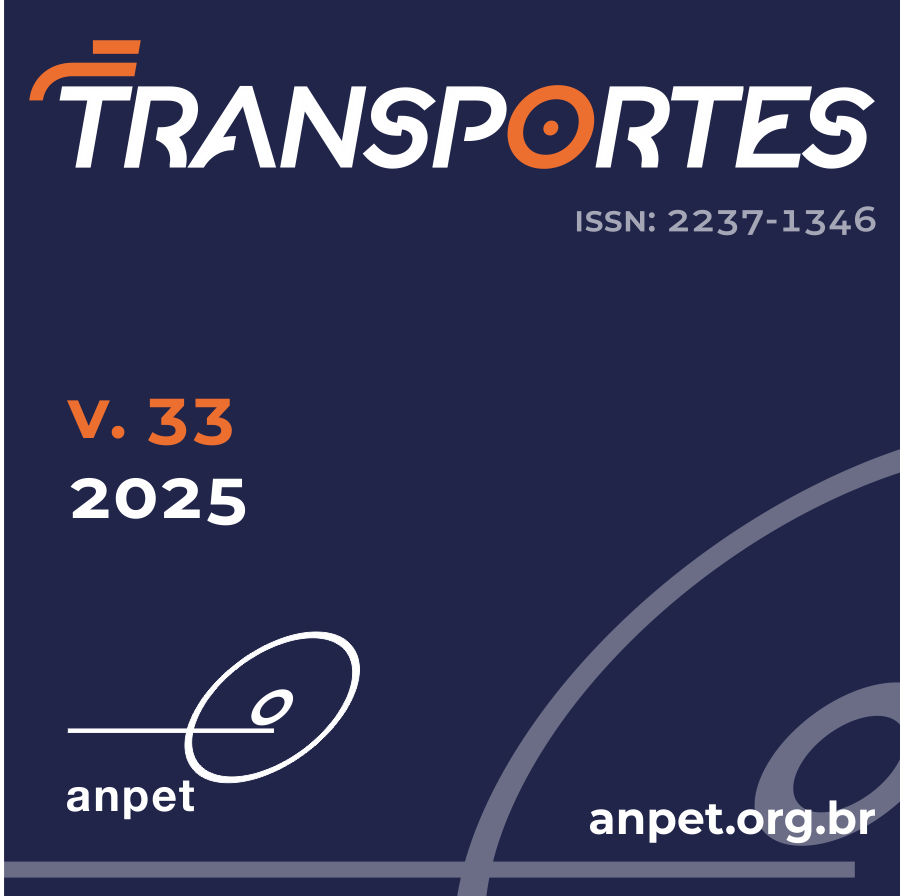Analysis of the effect of probabilistic response time at microsimulated intersections in AIMSUN
DOI:
https://doi.org/10.58922/transportes.v33.e3062Keywords:
Response time. Signalized intersections. Microsimulation. AIMSUN.Abstract
Signalized intersections are critical points in road infrastructure, often prone to congestion and accidents due to capacity limitations and traffic conflicts. Driver response time (RT), especially when prolonged, is a behavioral variable that affects traffic performance at these locations, contributing to increased delays and reduced road capacity. This study aimed to model and analyze the impact of drivers’ RT on traffic flow at signalized intersections using the AIMSUN microsimulation software. The methodology involved collecting RT and headway data at an intersection in Fortaleza, modeling the RT probability distribution, and implementing it in the simulator. Different scenarios were simulated by varying vehicle demand and RT to assess their impacts on average delay, v/c ratio, saturation flow, and the capacity of signalized approaches. The results showed that the log-normal distribution was the best fit to the RT data. Probabilistic modeling of RT in AIMSUN showed that the RT of the first vehicle in the queue (RT1) was higher than that of the subsequent vehicles. Incorporating probabilistic RT modeling increased delays and reduced capacity compared to the default model. The study highlights that probabilistic RT modeling affects the flow of microsimulated signalized intersections, particularly under more saturated traffic conditions.
Downloads
References
AIMSUN (2024). AIMSUN Next Users Manual, AIMSUN Next Version 24.0.1. Available at: <https://docs.AIMSUN.com/next/24.0.1/> (accessed 11/20/2024).
Çalişkanelli, P. and S. Tanyel (2018) Investigating the driver’s response time at signalized intersections, Transport, v. 33, n. 2, p. 380-388. DOI: 10.3846/16484142.2016.1250106. DOI: https://doi.org/10.3846/16484142.2016.1250106
Fitch, G.M.; S.A. Soccolich; F. Guo et al. (2013) The impact of hand-held and hands-free cell phone use on driving performance and safety-critical event risk. (Report No. DOT HS 811 757). Washington, DC: National Highway Traffic Safety Administration.
Fontes, D.B.; A.M. De Araújo and M.M. De Castro Neto (2022) Modelagem probabilística do tempo de resposta de motoristas em interseções semaforizadas no VISSIM, Transportes, v. 30, n. 1, p. 2501-2501. DOI: 10.14295/transportes.v30i1.2501. DOI: https://doi.org/10.14295/transportes.v30i1.2501
Hurwitz, D.S.; K.P. Heaslip; S.D. Schrock et al. (2013) Implications of distracted driving on start-up lost time for dual left-turn lanes, Journal of Transportation Engineering, v. 139, n. 9, p. 923-30. DOI: 10.1061/(ASCE)TE.1943-5436.0000569. DOI: https://doi.org/10.1061/(ASCE)TE.1943-5436.0000569
Li, Z.; J. Zhang; J. Rong et al. (2014) Measurement and comparative analysis of driver’s perception–reaction time to green phase at the intersections with and without a countdown timer, Transportation Research Part F: Traffic Psychology and Behaviour, v. 22, p. 50-62. DOI: 10.1016/j.trf.2013.10.012. DOI: https://doi.org/10.1016/j.trf.2013.10.012
Li, H. and P.D. Prevedouros (2002) Detailed observations of saturation headways and start-up lost times, Transportation Research Record: Journal of the Transportation Research Board, v. 1802, n. 1, p. 44-53. DOI: 10.3141/1802-06. DOI: https://doi.org/10.3141/1802-06
Nourzad, S.H.H.; D.D. Salvucci and A. Pradhan (2014) Computational modeling of driver distraction by integrating cognitive and agent-based traffic simulation models, Computing in Civil and Building Engineering, v. 2014, p. 1885-92. DOI: 10.1061/9780784413616.234. DOI: https://doi.org/10.1061/9780784413616.234
Murat, Y.S. and M. Cetin (2019) A new perspective for saturation flows at signalized intersections, Periodica Polytechnica. Civil Engineering, v. 63, n. 1, p. 296-307. DOI: 10.3311/PPci.11344. DOI: https://doi.org/10.3311/PPci.11344
Tonning, C.; T.K.O. Madsen; C.H. Bahnsen et al. (2017) Road user behavior analyzes based on video detections: Status and best practice examples from the RUBA software. In Proceedings of the 24th ITS World Congress (Los Angeles, CA). Dubai: ITS World, p. 1-10.
Xie, D.-F.; T.-L. Zhu and Q. Li (2020) Capturing driving behavior Heterogeneity based on trajectory data, International Journal of Modeling, Simulation, and Scientific Computing, v. 11, n. 03, p. 2050023. DOI: 10.1142/S1793962320500233. DOI: https://doi.org/10.1142/S1793962320500233
Downloads
Published
How to Cite
Issue
Section
License
Copyright (c) 2025 Wanderson Pedrosa, Manoel Castro-Neto, Alessandro Araújo

This work is licensed under a Creative Commons Attribution 4.0 International License.
Authors who submit papers for publication by TRANSPORTES agree to the following terms:
- The authors retain the copyright and grant Transportes the right of first publication of the manuscript, without any financial charge, and waive any other remuneration for its publication by ANPET.
- Upon publication by Transportes, the manuscript is automatically licensed under the Creative Commons License CC BY 4.0 license. This license permits the work to be shared with proper attribution to the authors and its original publication in this journal, and to be adapted for non-commercial purposes, provided appropriate credit is given and any derivative works are distributed under the same terms.
- Authors are authorized to enter into additional separate contracts for the non-exclusive distribution of the version of the manuscript published in this journal (e.g., publishing in an institutional repository or as a book chapter), with recognition of the initial publication in this journal, provided that such a contract does not imply an endorsement of the content of the manuscript or the new medium by ANPET.
- Authors are permitted and encouraged to publish and distribute their work online (e.g., in institutional repositories or on their personal websites) after the editorial process is complete. As Transportes provides open access to all published issues, authors are encouraged to use links to the DOI of their article in these cases.
- Authors guarantee that they have obtained the necessary authorization from their employers for the transfer of rights under this agreement, if these employers hold any copyright over the manuscript. Additionally, authors assume all responsibility for any copyright infringements by these employers, releasing ANPET and Transportes from any responsibility in this regard.
- Authors assume full responsibility for the content of the manuscript, including the necessary and appropriate authorizations for the disclosure of collected data and obtained results, releasing ANPET and Transportes from any responsibility in this regard.









